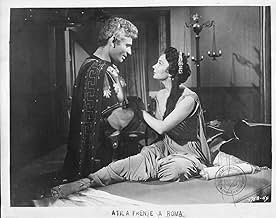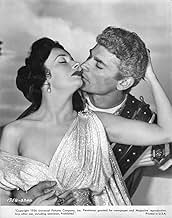With the Roman Empire divided, Attila the Hun hopes to conquer. In his way are a brave centurion, a beautiful princess...and Christianity.With the Roman Empire divided, Attila the Hun hopes to conquer. In his way are a brave centurion, a beautiful princess...and Christianity.With the Roman Empire divided, Attila the Hun hopes to conquer. In his way are a brave centurion, a beautiful princess...and Christianity.
Ludmilla Tchérina
- Princess Pulcheria
- (as Ludmilla Tcherina)
Robert Bice
- Chilothe
- (as Robo Bechi)
Storyline
Did you know
- TriviaFinal feature film of Moroni Olsen, who passed away about a month before its release.
- GoofsAll of the mounted troops have stirrups, which would not come into use in Europe for at least another four hundred years.
- Quotes
Pope Leo I: Rome is a Christian city, and the Temple of God!
- Crazy creditsAfter the list of actors at the start of the film it says: "AND Statesmen, Citizens, Soldiers of the Armies of the Roman Empire and the Hordes of Attila"
- ConnectionsReferenced in Pardon My Genie: Sister, Dear Sister (1972)
Featured review
At 7:05 pm on Saturday, 1 May 1976, BBC 1 showed the complete and uncut version of Sign of the Pagan. Puzzlingly, this was probably the last time that anyone was allowed to see Ludmilla Tcherina's exotic dance number. For reasons known only to the Universal studios, that whole sequence has been deleted from subsequent television showings, both on American station AMC and Britain's Channel 4. Nor do DVD releases contain the dance, even though the main title still credits Kenny Williams as choreographer, leaving viewers wondering what he could have possibly choreographed. Most surprising of all is the 2011 German DVD "special edition" which presents both the original wide screen and 4 x 3 versions. Even here, Universal have cleanly cut the dance number from both prints and both languages.
For those who have never seen the sequence, Attila has just won the palace show fight with Herculanas. After that, the Emperor commands his sister, the Princess Pulcheria, to dance for the visiting barbarians. For the first 50 seconds she performs a graceful and dignified piece of ballet which the barbarians obviously find boring. Therefore, the Emperor tells a servant, "Advise my sister this is not suited to barbarian taste." So ordered, the Princess switches to a more raunchy routine that the visitors find much more enjoyable. This lasts about two minutes. Few genre fans would argue that, in both the Hollywood and Italian epics, the exotic dance interlude is something of a highlight. We get to see beautiful girls in eye-catching costumes, always accompanied by some classy music. Indeed, the ballet score we hear (or used to hear) from Salter and Skinner in Sign of the Pagan is arguably the best music they ever composed.
Universal obviously hope no-one's going to notice what they've done, but why did they do it in the first place? One can only theorize. Perhaps the film was cut at some stage to fit into a fixed television slot. Or maybe the dance was excluded to make the film more suitable for children's matinees. Then nobody remembered to put the scene back? A somewhat wilder theory is that it's a rights issue. Remembering how the Gershwin estate, not liking the Porgy and Bess movie, have tried for years to prevent anyone seeing it, could Ludmilla Tcherina and her estate have somehow bought out this dance scene and are now withholding it because it does not enhance her memory as a classical ballerina? But surely Universal, with all their wealth, would hardly spoil one of their classics just to grab a few dollars?
Whatever the reason, most fans will agree that missing scenes in movies are a continuing source of irritation. Come on, Universal, put it back!
For those who have never seen the sequence, Attila has just won the palace show fight with Herculanas. After that, the Emperor commands his sister, the Princess Pulcheria, to dance for the visiting barbarians. For the first 50 seconds she performs a graceful and dignified piece of ballet which the barbarians obviously find boring. Therefore, the Emperor tells a servant, "Advise my sister this is not suited to barbarian taste." So ordered, the Princess switches to a more raunchy routine that the visitors find much more enjoyable. This lasts about two minutes. Few genre fans would argue that, in both the Hollywood and Italian epics, the exotic dance interlude is something of a highlight. We get to see beautiful girls in eye-catching costumes, always accompanied by some classy music. Indeed, the ballet score we hear (or used to hear) from Salter and Skinner in Sign of the Pagan is arguably the best music they ever composed.
Universal obviously hope no-one's going to notice what they've done, but why did they do it in the first place? One can only theorize. Perhaps the film was cut at some stage to fit into a fixed television slot. Or maybe the dance was excluded to make the film more suitable for children's matinees. Then nobody remembered to put the scene back? A somewhat wilder theory is that it's a rights issue. Remembering how the Gershwin estate, not liking the Porgy and Bess movie, have tried for years to prevent anyone seeing it, could Ludmilla Tcherina and her estate have somehow bought out this dance scene and are now withholding it because it does not enhance her memory as a classical ballerina? But surely Universal, with all their wealth, would hardly spoil one of their classics just to grab a few dollars?
Whatever the reason, most fans will agree that missing scenes in movies are a continuing source of irritation. Come on, Universal, put it back!
- How long is Sign of the Pagan?Powered by Alexa
Details
- Release date
- Country of origin
- Language
- Also known as
- Attila, der Hunnenkönig
- Filming locations
- Production company
- See more company credits at IMDbPro
Box office
- Budget
- $1,300,000 (estimated)
- Runtime1 hour 32 minutes
Contribute to this page
Suggest an edit or add missing content







































